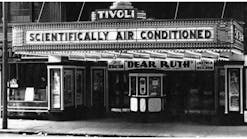The air conditioning in a tanning salon had not worked correctly all summer. That was not good: Tanning customers want to look like they have spent all day at the beach, not like they have sweated it out in a sauna.
“Oh, and one thing more,” the salon manager said. “We had a flood in here a couple of weeks ago, and we had to turn the air conditioning off altogether since then.”
I quickly figured that the flood was caused by a split U-bend in the hot-water heating coil in the salon's small air handler. The only time water coils split like that is when they freeze. Freezing cold air flowing over a coil will freeze the water in the two adjacent tubes, trapping unfrozen water in the U-shaped bend that connects the tubes. When the water in the tubes freezes, it expands. However, no space is available to absorb the expansion. Tremendous pressure builds up, and the U-bend splits open. But this was October — the weather had not yet been nearly cold enough to freeze a coil.
“Well,” I thought, “I'll have to figure out why that coil split, but, meanwhile, these people need air conditioning, and a split heating coil is no reason to shut off the air conditioning completely.”
So, I turned the air conditioning back on, but nothing happened. Was it the thermostat? The wiring? The controls? (The HVAC system was a high-efficiency system. With a two-speed air-conditioning compressor, variable-speed fan control, and a zone control system, the tangle of controls wiring looked like something out of “Star Wars.”)
As I sat in front of the unit tracing wiring and poring over the controls schematics, I felt a slight cool breeze coming through the open door of the fan section.
“It must be outdoor air coming in,” I thought, as I concentrated on the wiring schematics. However, the longer I sat, the colder and stronger the breeze felt. I suddenly realized what had happened: The air conditioning was working fine; it was the fan motor that had failed.
The air conditioning cooled the air-conditioning coil, which was right on top of the hot-water coil. With no fan to circulate the cooling, the air-conditioning coil got very cold — icy cold, in fact. So much cold air dropped down from the air-conditioning coil and flowed over the hot-water coil that it froze the water inside of the hot-water coil. That explained the other mystery, too. The air conditioning had not worked very well that summer because the fan had not been running.
Have a “war story” to share? Send it to Executive Editor Scott Arnold at [email protected]. Authors are paid $50 per published war story.








